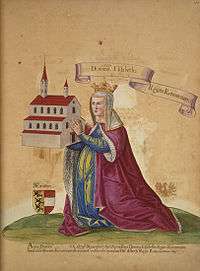Elizabeth of Carinthia, Queen of Germany
| Elizabeth of Carinthia | |
|---|---|
 | |
| German Queen | |
| Tenure | 1299 – 1 May 1308 |
| Born | c. 1262 |
| Died |
28 October 1312 Königsfelden Monastery |
| Burial | Königsfelden Monastery |
| Spouse | Albert I of Germany |
| Issue |
Rudolf I of Bohemia Frederick the Fair Leopold I, Duke of Austria Albert II, Duke of Austria Otto, Duke of Austria Anna, Duchess of Breig Agnes, Queen of Hungary Elisabeth, Duchess of Lorraine Catherine, Duchess of Calabria Judith, Countess of Öttingen |
| House | House of Gorizia |
| Father | Meinhard, Duke of Carinthia |
| Mother | Elisabeth of Bavaria |
Elizabeth of Carinthia (c. 1262 – 28 October 1312) from the House of Meinhardin was Queen of the Romans, Queen of Germany and Duchess of Austria by marriage. She is also known as Elizabeth of Tyrol.
Family
She was the eldest daughter of Meinhard, Duke of Carinthia, Count of Gorizia and Tyrol.
Her mother was Elizabeth of Bavaria, daughter of Otto II, Duke of Bavaria and his wife Agnes, herself daughter of Henry V, Count Palatine of the Rhine and Agnes of Hohenstaufen. Her mother was also the widow of Conrad IV of Germany. Therefore, the young Elizabeth was a half-sister of Conradin, King of Jerusalem and Duke of Swabia.
Marriage
She was married in Vienna on 20 December 1274 to the future Albert I of Germany, one of the founders of the House of Habsburg, thus becoming daughter-in-law of the King of the Romans. Her husband, then a Count of Habsburg, was invested as Duke of Austria and Styria in December 1282 by his father King Rudolf I. They solidified their rule in what was to become the Habsburg patrimony, also with the help of Elizabeth's father who in his turn in 1286 was created Duke of Carinthia.
Elizabeth was in fact better connected to powerful German rulers than her husband: a descendant of earlier kings, for example Henry IV, Holy Roman Emperor, she was also a niece of dukes of Bavaria,[1] Austria's important neighbours.
In 1298, her husband was finally elected king upon the end of the reign of Adolf of Nassau. In 1299 she was Nuremberg was crowned Queen of Germany and the Romans. Her husband was murdered on 1 May 1308 by his nephew John "the Parricide" in Windisch, located in modern-day Switzerland.
After the murder of her husband, Elizabeth joined the monastery of Königsfelden where she died on 28 October 1312 and was later buried.[2]
Elizabeth was a shrewd and enterprising woman who had some commercial talents. The construction of the Saline plant in Salzkammergut goes back to her suggestion.[3]
Their children were:
- Rudolf III (ca. 1282 – 4 July 1307), married but line extinct. He predeceased his father.
- Frederick I (1289 – 13 January 1330). Married but line extinct.
- Leopold I (4 August 1290 – 28 February 1326, Strassburg).
- Albert II (12 December 1298, Vienna – 20 July 1358, Vienna).
- Henry the Gentle (1299 – 3 February 1327, Bruck an der Mur). Married but line extinct.
- Meinhard, 1300 died young.
- Otto (23 July 1301, Vienna – 26 February 1339, Vienna). Married but line extinct.
- Anna 1280?, Vienna – 19 March 1327, Breslau), married:
- in Graz ca. 1295 to Margrave Hermann of Brandenburg;
- in Breslau 1310 to Duke Heinrich VI of Breslau.
- Agnes (18 May 1281 – 10 June 1364, Königsfelden), married in Vienna 13 February 1296 King Andrew III of Hungary.
- Elisabeth (d. 19 May 1353), married 1304 Frederick IV, Duke of Lorraine.
- Catherine (1295 – 18 January 1323, Naples), married 1316 Charles, Duke of Calabria.
- Jutta (d. 1329), married in Baden 26 March 1319 Count Ludwig VI of Öttingen.

Ancestry
| Ancestors of Elizabeth of Carinthia, Queen of Germany | ||||||||||||||||||||||||||||||||||||||||||||||||||||||||||||||||||||||||||||||||||||||||||||||||||||||||||||||||||||||||||||||||||||||||||||||||||||||||||||||||||||||||||||||||||||||||||||||||||||||||||||||||||||||||||||||||||||||||||||||||||||||||||||||||||||||||||||||||||||||||||||||||||||||||||||||||||||||||||||||||||||||||||||||||||||||||||||||||||||||||||||||||||||||||||||||||||||||||||||||||||||||||||||||||||||||||||||||||||||||||||||||||||||||||||||||||||||||||||||||||||||||||||||||||||||||||||||||||||
|---|---|---|---|---|---|---|---|---|---|---|---|---|---|---|---|---|---|---|---|---|---|---|---|---|---|---|---|---|---|---|---|---|---|---|---|---|---|---|---|---|---|---|---|---|---|---|---|---|---|---|---|---|---|---|---|---|---|---|---|---|---|---|---|---|---|---|---|---|---|---|---|---|---|---|---|---|---|---|---|---|---|---|---|---|---|---|---|---|---|---|---|---|---|---|---|---|---|---|---|---|---|---|---|---|---|---|---|---|---|---|---|---|---|---|---|---|---|---|---|---|---|---|---|---|---|---|---|---|---|---|---|---|---|---|---|---|---|---|---|---|---|---|---|---|---|---|---|---|---|---|---|---|---|---|---|---|---|---|---|---|---|---|---|---|---|---|---|---|---|---|---|---|---|---|---|---|---|---|---|---|---|---|---|---|---|---|---|---|---|---|---|---|---|---|---|---|---|---|---|---|---|---|---|---|---|---|---|---|---|---|---|---|---|---|---|---|---|---|---|---|---|---|---|---|---|---|---|---|---|---|---|---|---|---|---|---|---|---|---|---|---|---|---|---|---|---|---|---|---|---|---|---|---|---|---|---|---|---|---|---|---|---|---|---|---|---|---|---|---|---|---|---|---|---|---|---|---|---|---|---|---|---|---|---|---|---|---|---|---|---|---|---|---|---|---|---|---|---|---|---|---|---|---|---|---|---|---|---|---|---|---|---|---|---|---|---|---|---|---|---|---|---|---|---|---|---|---|---|---|---|---|---|---|---|---|---|---|---|---|---|---|---|---|---|---|---|---|---|---|---|---|---|---|---|---|---|---|---|---|---|---|---|---|---|---|---|---|---|---|---|---|---|---|---|---|---|---|---|---|---|---|---|---|---|---|---|---|---|---|---|---|---|---|---|---|---|---|---|---|---|---|---|---|---|---|---|---|---|---|---|---|---|---|---|---|---|---|---|---|---|---|---|---|---|---|---|---|---|---|---|---|---|---|---|---|---|---|---|---|---|---|---|---|---|---|---|---|---|---|---|---|---|---|---|---|---|---|---|---|---|---|---|---|---|---|---|---|---|---|---|---|---|---|---|---|---|---|---|---|---|---|---|---|---|---|---|---|---|---|---|---|---|---|---|---|---|---|---|---|---|---|---|---|---|---|---|---|---|---|---|---|---|---|---|
| ||||||||||||||||||||||||||||||||||||||||||||||||||||||||||||||||||||||||||||||||||||||||||||||||||||||||||||||||||||||||||||||||||||||||||||||||||||||||||||||||||||||||||||||||||||||||||||||||||||||||||||||||||||||||||||||||||||||||||||||||||||||||||||||||||||||||||||||||||||||||||||||||||||||||||||||||||||||||||||||||||||||||||||||||||||||||||||||||||||||||||||||||||||||||||||||||||||||||||||||||||||||||||||||||||||||||||||||||||||||||||||||||||||||||||||||||||||||||||||||||||||||||||||||||||||||||||||||||||
References
- ↑ A list of her maternal ancestors
- ↑ Cawley, Charles, CARINTHIA, Medieval Lands, Medieval Lands database, Foundation for Medieval Genealogy,
- ↑ Translation from German Wikipedia
| Preceded by Imagina of Isenburg-Limburg |
German Queen 1298 – 1 May 1308 |
Succeeded by Margaret of Brabant |